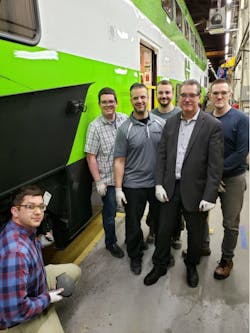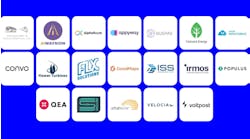Rail technology continues to develop as transit agencies look for ways to provide faster, safer and more reliable service. As the number of operating systems increase and the amount of data needed increase, companies are providing innovations that enhance connectivity and communication. To achieve this, innovations coming to the industry focus on improving or creating a digital framework, bettering rail crossing safety, 3D printing discontinued parts and strengthening Wi-Fi connectivity.
Unifying data through a connected transportation platform
Capitalizing on digital technologies allows operators to offer safer and more satisfying customer experiences while improving the workforce communication and productivity, according to Brad Fellows, a managing partner for consulting in travel, transportation and hospitality at DXC Technology.
“Many mass transit organizations are striving to build the foundation and or the digital framework toward capitalizing on these emerging technologies,” Fellows said. “This can span solutions for Transit Enterprise Asset Management (TAM), cloud solutions, creating new applications, improving security measures, increasing data storage capacity and advancing workplace and mobility capabilities for their customers and workforces.”
Because of the level of impact, it’s important for rail operators to become digitalized, which helps rail organizations be as efficient as possible with mission-critical systems while improving safety, Fellows explained. Digitalization also allows for precision scheduling, which allows for more service options. Being able to implement the more complex data solutions requires a unified connection that allows the data to communicate across all operations.
“Digital transformation is about becoming part of an ecosystem that not only shares data but also delivers context and intent,” Fellows said. “It is built around an information architecture that enables companies to look across a chain of travel events for an individual customer or package to identify potential challenges, predict the impact and automatically develop and execute solutions that keep transit services moving.”
Digital safety solutions for rail crossings
Technology can also provide enhanced railroad safety and remote monitoring, something L.B. Foster Company is currently focusing on with its Grade Crossing Monitoring system, which uses Light Detection and Ranging (LIDAR) to detect an object on track, as well as its size, location and direction of travel.
“The LIDAR is designed to detect small children and adults as well as vehicles and other large objects in the crossing,” said Michael O’Connell, manager technical sales for the Americas at L.B. Foster. “If something or someone is identified within the crossing, the Grade Crossing Monitoring system can stop or slow the train through signaling or [positive train control] integration.”
Transit agencies can use the system to control the crossing gates and the exit gates of a four-quad system. If nothing is detected, all four gates will close and completely seal the crossing, preventing cars from weaving through the gates.
“If an obstacle is detected while the train approaches, the system will delay the closing of the exit gates allowing the vehicle to exit without becoming entrapped,” O’Connell explained. “The system is protected by rugged steel housings with motorized shutters to prevent vandalism as well as contamination and damage from passing trains.”
O’Connell explains that agencies will see lower life-cycle costs because minimal maintenance is required, along with a better product replacement cycle.
“Utilizing intelligent algorithms to more accurately provide key measurements such as direction and velocity, train delays are reduced due to near zero false alarms,” O’Connell said.
Providing necessary parts with 3D printing
Technology can also help with the maintenance of a rail system; for instance, creating a discontinued part for a rail vehicle. Bombardier Transportation has been 3D printing a water fill cap for its BiLevel commuter rail cars after a vendor discontinued production. The3D printing technology has allowed it to improve the design, reduce production and delivery time from days to hours, and reduce costs by 90 percent, according to Alex Rotar, Industry 4.0 specialist in additive manufacturing at Bombardier.
“Our engineering, technical services, industrialization and project management teams combined efforts develop[ed] and produce[d] 3D printed prototypes of the part and [qualified] them with laboratory tests,” Rotar explained.
Once satisfied with the results, the team asked GO Transit in Toronto, Ontario, Canada, if the part could be of use for the cars currently in production.
“GO Transit agreed, making the cap the first 3D polymer printed part on a Bombardier car in North America,” Rotar said. “The 3D printed caps are currently being tested on five cars in Toronto to see how they perform in service, over time and in the Canadian climate.”
The 3D printed cap went from a traditional welded assembly to being designed for additive manufacturing. The part now only uses one piece of steel and has been simplified to an “integrated hinge part,” Rotar said. And as the product is put to the test, it could open doors for more 3D printed possibilities.
“As the new fiberglass-reinforced polyamide material meets fire, smoke and toxicity requirements for the North American market, we are investigating additional applications for 3D printed spare parts, customized parts, and manufacturing tools, made in-house and on-demand,” Rotar said.
Creating stronger Wi-Fi connectivity
In order to access technology solutions, transit organizations most have a strong and robust Wi-Fi network that can support the large quantities of data necessary to operate a seamless system. The network needs to be reliable and secure to allow for real-time information that allows the transit system to operate as efficiently as possible.
“Rail operators recognize that the reliability and timeliness of their service is important to customers,” said Maria Waddy, North American product lead for Icomera US, Inc. “They will increasingly use digitalization of onboard systems and remote diagnostics to improve operational efficiency.”
She notes that operational efficiency translates to efficient maintenance, which can lower costs or free up resources to do more work. Because technology can help prevent unscheduled maintenance, more vehicles will be in service, improving on-time performance.
“Wireless internet connectivity can also be utilized by operators to monitor other onboard systems remotely, and to derive insights and value from the available statistics, improving fleet performance and management,” Waddy explained.
As the number of internet-connected onboard systems increases, operators can face the challenge of having to install multiple hardware and software pieces on the vehicles, with each piece having its own processes to manage it, according to Waddy.
“Icomera is reducing the need for additional hardware and software by running multiple virtual applications from a single platform, delivering a powerful connectivity solution with the necessary computer processing power and storage needed for supporting resource-intensive applications such as passenger Wi-Fi, Infotainment and real-time CCTV simultaneously as part of a single solution,” Waddy said.
Looking to the future
These technologies are designed to reduce maintenance, improve service and enhance safety and security. And advancements are being made every year to keep bettering the industry and the services offered, with a vision of creating a connected journey.

Megan Perrero | Editor in Chief
Megan Perrero is a national award-winning B2B journalist and lover of all things transit. Currently, she is the Editor in Chief of Mass Transit magazine, where she develops and leads a multi-channel editorial strategy while reporting on the North American public transit industry.
Prior to her position with Mass Transit, Perrero was the senior communications and external relations specialist for the Shared-Use Mobility Center, where she was responsible for helping develop internal/external communications, plan the National Shared Mobility Summit and manage brand strategy and marketing campaigns.
Perrero serves as the board secretary for Latinos In Transit and is a member of the American Public Transportation Association Marketing and Communications Committee. She holds a bachelor’s degree in multimedia journalism with a concentration in magazine writing and a minor in public relations from Columbia College Chicago.



